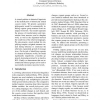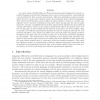1007 search results - page 21 / 202 » Optimal phylogenetic reconstruction |
CSB
2003
IEEE
15 years 5 months ago
2003
IEEE
A new and essentially simple method to reconstruct prokaryotic phylogenetic trees from their complete genome data without using sequence alignment is proposed. It is based on the ...
ACL
2010
14 years 9 months ago
2010
A central problem in historical linguistics is the identification of historically related cognate words. We present a generative phylogenetic model for automatically inducing cogn...
IPPS
2007
IEEE
15 years 6 months ago
2007
IEEE
Computational phylogeny is a challenging application even for the most powerful supercomputers. It is also an ideal candidate for benchmarking emerging multiprocessor architecture...
BMCBI
2007
14 years 12 months ago
2007
Background: Maximum parsimony phylogenetic tree reconstruction from genetic variation data is a fundamental problem in computational genetics with many practical applications in p...
COCOON
2006
Springer
15 years 3 months ago
2006
Springer
In a recent article, Nakhleh, Ringe and Warnow introduced perfect phylogenetic networks--a model of language evolution where languages do not evolve via clean speciation--and form...


